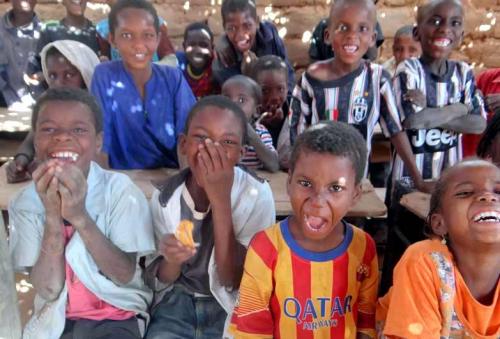Futures of freedom
To mark World Day Against Child Labour on 12 June, Jakub Sobik takes a closer look at child slavery, and highlights what Anti-Slavery is doing to tackle it.
Today there are an estimated 10 million children in slavery across the world. Children who are forced into back-breaking work in mines, brick kilns, sweatshops and private homes. Children who are forced into sexual exploitation or early marriage. Children who get exploited as soldiers, or are forced to beg, or sell drugs.

Children of slave descent in school founded by Anti-Slavery International in Niger.
Like Ananya* from India, who had to wake up at midnight and work through the night to prepare bricks for moulding.
Like Oumar* in Senegal, who had to spend hours begging every day just to earn enough to eat and avoid being harshly punished by his master.
Like Irene* in Tanzania, who was beaten by her employer every time she wanted to take a short break from her domestic chores. There are 10 million children who, instead of going to school and spending their days playing with their friends, get exploited for someone else’s gain. They suffer abuse, fear and isolation.
The vicious cycle of child slavery
Children are particularly vulnerable to exploitation because it’s much easier to deceive a child.
Sadly, the vicious cycle of slavery rarely ends with survivors escaping their captors, because children rarely receive a formal education whilst in captivity and have trouble finding employment later in life.
Additionally, the trauma of abuse often affects every aspect of a child’s life, including their health and the ability to build normal relationships with other people.
Many survivors are likely to stay in poverty, in low skilled and low paid jobs. In turn, they will have little chance of providing their own children with an education and a good start to their lives.
Building freedom for the long run
Anti-Slavery works with children in many countries across the world, and every project operates in a completely different cultural context. However, one common theme applies: we work to secure a long-term future of freedom for children and families affected by slavery.
We do this by focusing on protecting vulnerable children from immediate exploitation and abuse, while ensuring that our work is sustainable in the
long term, preventing future children from exploitation.
We support children to become less vulnerable by enabling them to defend their rights and providing them with access to education to help increase their chances of finding decent
employment.
For example, in Niger we created six schools for families born into slavery and controlled by their masters. This was the first time that children from these families had access to any formal education. A decade on, the families are completely free from their masters’ influence. Their children perform way above the national average on school exams, and the first children have started attending secondary education.
The communities which have formed around the schools have also helped to advocate with the government to build three additional schools in other areas.
We’re also making sure that we don’t leave the most vulnerable communities behind. For example, we have recently started a project on tackling forced child begging in Niger and Mali – an issue that no international organisation has addressed so far .
We change children’s futures. The transformations we witness every day give us hope that we can raise a new generation who will ensure that slavery is no longer acceptable, and no longer possible.
We won’t stop until every single child around the world is free from slavery.
Source:Anti-Slavery
- 309 reads
Human Rights
Fostering a More Humane World: The 28th Eurasian Economic Summi

Conscience, Hope, and Action: Keys to Global Peace and Sustainability

Ringing FOWPAL’s Peace Bell for the World:Nobel Peace Prize Laureates’ Visions and Actions

Protecting the World’s Cultural Diversity for a Sustainable Future

Puppet Show I International Friendship Day 2020

